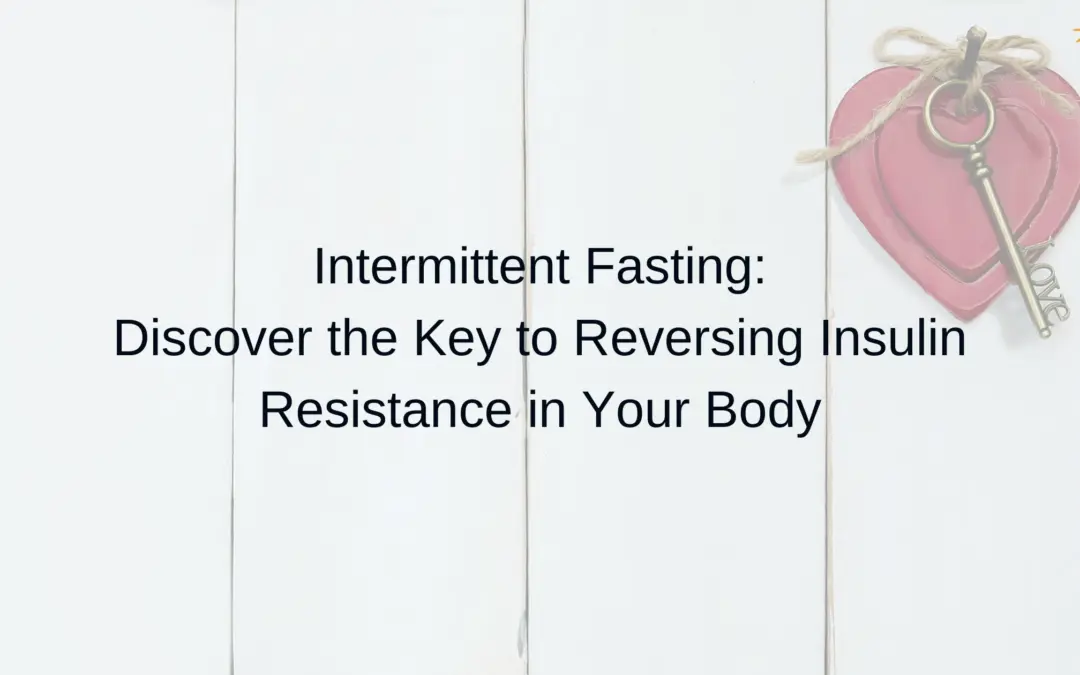Intermittent Fasting: Discover the Key to Reversing Insulin Resistance in Your Body
Even before modern science demonstrated the many health benefits of intermittent fasting, ancient people practiced fasting.
Hippocrates, the ancient Greek physician, recommended fasting for patients who had certain symptoms and illnesses.
Many religions practice fasting for spiritual reasons. Others practice fasting for mental clarity and to provide a resting phase for their body.
Today, intermittent fasting is gaining popularity as a way to improve health, reverse insulin resistance, and lose weight.
In this article, we’ll discover how intermittent fasting is the key to reversing insulin resistance.
What is Intermittent Fasting?
Fasting is the practice of abstaining from food, drink, or both for a period of time. People fast for several reasons including health, religious, or ethical reasons.
Intermittent fasting is a way of eating. It’s the practice of fasting for a certain period of time and then eating again. You repeat this intermittent schedule for as long as you like.
Many people adopt intermittent fasting as their primary way of eating for the rest of their lives.
Intermittent Fasting Benefits
Although the practice of fasting and intermittent fasting (IF) has been around for thousands of years, modern science is now diving deep into the many health benefits it holds for our bodies.
It wasn’t until the latter part of the 19th century when scientists carried out some of the first organized studies on fasting. Since then, intermittent fasting has been established as being very beneficial to our health in many ways, including:
- Reducing insulin resistance
- Cellular repair
- Increasing human growth hormone
- Weight loss
- Reducing inflammation
- Longevity and anti-aging
With so many incredible benefits of intermittent fasting, you might be wondering if IF is right for you. Some people wonder if it will be too hard for them. The truth is, there are many different ways to practice IF. Let’s talk about a few of the most popular ways.
Intermittent Fasting Schedule
In the 20th century, we learned more about our body’s nutritional needs. Different methods of fasting emerged. Some fasting protocols are simple day to day intermittent fasting, some fasting protocols might last for a month or more. Longer fasts are done in a clinic or hospital under the direction of a doctor.
But you don’t have to fast for thirty days to see benefits. You don’t even have to fast for 3 days. Most people start with one of these three options:
The 16:8 Schedule
The 16:8 intermittent fasting schedule is popular among people new to intermittent fasting. This is how it works.
We have twenty-four hours in a day. The 16 refers to the number of hours you fast. The 8 refers to the number of hours in which you eat. It doesn’t mean that you eat non-stop for eight hours. It just means that within those eight hours, you eat all your meals. During the sixteen fasting hours, you do not eat, but, you may drink water, tea, or coffee.
The 5:2 Diet
The 5:2 Diet is a schedule in which you eat like normal five days of the week and then fast, or restrict calories, for two days of the week. Generally, you restrict calories on those two days to 500-800 calories per day. Fewer calories if you are a woman, more if you are a man.
The other caveat is that the two fasting or calorie-restricted days are not back to back. For instance, you may eat normally for a couple of days and then fast for one day. It might look like this:
- Day 1 — Eat as usual
- Day 2 — Eat as usual
- Day 3 — Fast or restrict calories
- Day 4 — Eat as usual
- Day 5 — Eat as usual
- Day 6 — Fast or restrict calories
- Day 7 — Eat as usual
Alternate Day Fasting
Alternate Day Fasting or ADF is an intermittent fasting schedule where you eat normally one day and then fast the next. You alternate between fasting days and eating days.
On fasting days, you may drink calorie-free drinks like water, coffee, and tea. You also have an option to eat 500 calories on the fasting day. For better results, I will recommend no calories at all on the fasting day.
Alternate day fasting is a popular option for health and weight loss. There is no restriction on what you eat during normal eating days. Although choosing foods high in nutrients is more beneficial for your health and for keeping glucose and insulin levels in a normal range.
What is Insulin Resistance?
Before we discover the key to reversing insulin resistance in your body, we need to understand what insulin resistance is.
Insulin resistance happens when the body’s cells become resistant to the effects of insulin. Insulin is a hormone that regulates blood sugar levels in your blood. It is often called the fat-storage hormone because it blocks fat burning.
When you eat, your pancreas releases insulin. Insulin then travels through your blood and picks up glucose. It takes it to your cells and deposits the glucose in the cell. The cell then uses glucose for energy when needed.
But sometimes the cell won’t open up for the insulin. The cell is insulin resistant. We also call this metabolic syndrome.
How does the cell become insulin resistant? The fact is that the cell is already full and can’t take any more glucose. So in response, the pancreas sends out more insulin to help.
In the end, your body has chronically high levels of insulin and glucose and you are now insulin resistant.
Insulin resistance doesn’t happen overnight. It builds up over time and creates several health risks such as type 2 diabetes.
Risk Factors for Insulin Resistance
It’s hard to determine if you are insulin resistant. There aren’t really any symptoms to identify it. You may not know that you are slowly becoming insulin resistant. But there are several signs and risk factors to look for. Some of these include:
- Obesity
- Inactive lifestyle
- Diet high in simple carbohydrates and sugar
- High blood pressure
- Smoking
If you have one or more of these risk factors, you may be insulin resistant. What can you do to reduce and reverse insulin resistance?
You can become more active, work on your nutrition, get better sleep, and practice intermittent fasting.

Can Intermittent Fasting Reverse Insulin Resistance?
Our liver and muscles store a small supply of glycogen for use when we need energy. But after anywhere from twelve to twenty-four hours of fasting, that supply of glycogen becomes depleted.
Once this happens, your body needs to find fuel somewhere. If there is no food coming in, it will tap into your fat stores.
The key is to allow your body to use its supply of glycogen and then start using its supply of energy from stored fat.
Remember, the job of insulin is to take glucose and drive it into the cell. But if the cell is already full, insulin can’t do its job. The pancreas sends out more insulin to help. And you end up with a vicious cycle of high insulin, high blood sugar, and insulin resistance.
When we fast, our blood glucose levels naturally go down. Which in turn helps our insulin levels go down. Then we can also access our stored fat. All of these factors work together to reduce and reverse insulin resistance.
Intermittent fasting is the key to allowing your body to naturally reduce insulin.
How Long Does it Take to Improve Insulin Resistance?
How long do you need to practice intermittent fasting to reverse insulin resistance? The answer depends on the individual.
Someone who is obese, has fatty liver disease, and has been insulin resistant for a long time will need more time to reverse it. Just as it takes time for insulin resistance to build up, it takes time to reduce insulin levels and start burning fat.
In a clinical setting, obese patients follow a slow and careful protocol. First, they remove refined carbohydrates from their diet. Then they eat a lower-carb diet that includes healthy fats and moderate protein.
Their first fast, supervised by the doctors in the clinic, might be thirty-six hours to three days. This fast starts the process of reversing insulin resistance. After that, the patient can adopt an intermittent fasting schedule along with dietary changes.
A person who is overweight, but not obese can improve insulin resistance much faster. Removing refined carbohydrates and sugar is the first step. Next comes adding in vegetables and healthy fats.
Exercise also helps reduce insulin resistance by using the glycogen stored in the muscles. For an overweight person, insulin levels might begin to drop in a few days of intermittent fasting.
What Does Fasting Do to Insulin Levels?
When you fast, insulin levels begin to drop. Insulin resistance begins to reverse when insulin levels drop.
Through fasting, you allow your body to use the stored glycogen in your cells. Remember, insulin resistance occurs when the cells are full and resistant to the efforts of insulin.
By allowing the cells to empty, insulin levels naturally lower as it is no longer needed.
Final Thoughts on the Key to Reversing Insulin Resistance
We’ve talked about how insulin resistance occurs in the body and the risk factors to watch out for. Also, we learned how insulin works and how we slowly become insulin resistant. We’ve discovered how intermittent fasting is the key to reversing insulin resistance.
And it just might be the key for you.
How are you feeling? Are you tired all the time? Have you hit a weight loss plateau? Do you crave sweets and then feel guilty when you cave?
If you are nodding your head while reading this, I understand. I know because I’ve been where you are.
And that’s why I coach women like you every day. I want you to know how extraordinary fasting is. It changed my life and it can change yours.
See yourself feeling full of energy without starting your day with multiple cups of coffee.
Imagine looking and feeling younger.
Imagine losing weight without spending hours on the treadmill or depriving yourself of your favorite foods.
Can you see the happy vibrant woman you can become?
I want to get to know you and help you transform into that woman. I’m ready to help you reach your goals. Women who have a support system and a personal accountability coach have a higher rate of success than those who try to go it alone.
Are you ready to change your life?
Click the button below to schedule your complimentary consultation.




